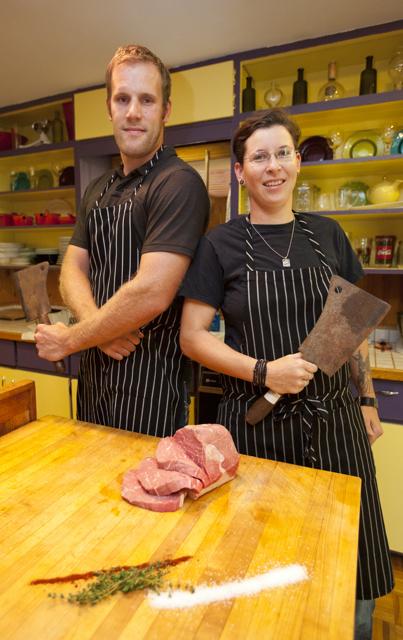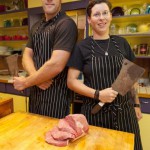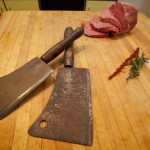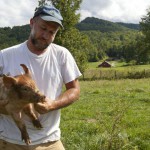- Chopped: Josh Wright and Karen Fowler are bringing butchery back. Photos by Jonathan Welch
- This little piggy went to market: Casey Mckissick says that transparency is missing in many aspects of the meat industry.
Butchery: It's a tough, dirty job, but more and more young culinary professionals are abandoning the nightly beat-down of working the line to do it. Tattooed and wielding heavy cleavers (and knife cases boasting more sharp tools than an operating room), a new brand of neighborhood butcher is reviving the craft.
On Thursday, Sept. 29, Asheville gets its first real butcher shop in recent history, when The Chop Shop opens. Owner Josh Wright, along with butcher Karen Fowler, will provide a full-body experience, so to speak. The Chop Shop will receive and break down entire animals, rather than simply carving up primals (large portions such as the primal chuck and round), or subprimals (like whole loins and briskets) — typical practice in the average grocery-store meat department.
Does it make a difference? Absolutely, say Fowler and Wright. First and foremost, butchering whole animals is a more sustainable practice because it helps facilitate the use of every part. "I want to get a really good yield off of a whole animal and educate people on what to do with the whole animal," says Fowler. If the Chop Shop runs out of flank steaks — there are only two on each animal — Fowler might try to gently guide customers toward more obscure cuts. "We're not going to be high and mighty about it, but I might say, 'At less per pound, we can try this cut and I can talk you through how to cook it and give you ideas and resources.'"
In that way, Fowler says, she can be both craftsperson and educator, talking to people about using parts they might not have known were just as good — and cheaper — simply because they haven’t been exposed to them. "We're going to work hard to give people what they want, of course, but we're also trying to be sustainable and utilize the whole animal — that means we have to move the whole animal, and that may take education. But it's all about being responsible and eating responsibly."
Old-school meets new-school
Butchery is a craft as old as animal husbandry itself; butcher’s guilds have been traced back as far as the 1200s. But like many hands-on, specific artisan skills, butchery’s popularity declined over the years, concurrent with the rise of grocery superstores. “The rise of the conglomerate grocery and one-stop shop has put the craft on the back-burner to convenience," says Wright. And yes, real butchery is a craft, he says. The grocery-store butcher tends to cut meat, wrap it in cellophane and generally go about the day slicing, with little interaction with the customers. “Are there lots of people that know how to cut meat? Yes," says Fowler. "Are there people that really know what to do with something that's whole? Not as much, but I think, yes, it's on the rise.” With the Food Channel naming the neighborhood butcher shop among the 10 food trends to watch for 2011, that seems to be the case.
A matter of convenience
Casey McKissick is the coordinator for N.C. Choices, a WNC-based program that promotes sustainable food and farming systems — specifically, pasture-based meat. "We're a very small organization with a very specific mandate that's large for the type of staff and funding that we have," McKissick says. A small part of what the organization does is provide technical information and educational opportunities to help improve meat production, processing and ethical business practices. McKissick is himself a farmer who owns Crooked Creek Farms with his wife, Meredith.
Though the meat industry is becoming more localized, it’s not quite easy to steer such big business in a different direction. "The whole meat industry changed to meet the needs of the [larger grocery stores] out there to where the decision about where a whole beef carcass goes is made in some place in Nebraska," he says. A large-scale meat producer is likely to have so many animals on hand that decisions on where all of the loins versus all of the hams will be shipped can be based upon where the market is the most fruitful. “Whereas, what The Chop Shop is doing is taking on that tradition of the old butcher shop, where it's the responsibility of the butcher to move the whole animal,” McKissick says. That’s much less disconcerting than imagining parts from one animal scattered all over the country.
And historically, says McKissick, each animal stayed within the community out of necessity. The butcher couldn't simply order a truck to bring over a box of six loins, he says. "They had to buy the whole animal from the farmer. So the butcher had to be creative; he had to know how to cut meat right, and know how to tell people how to cook each thing," he says. "It requires a whole other level of intellectual knowledge that the people cutting meat at the grocery store don't necessarily have."
Picking your brain
The butcher was once a neighborhood fixture who knew that Mrs. Jones favored ham bones on Fridays and that Mr. Brown would snap up the liver. Fowler says that’s the sort of tradition that she and Wright want to bring to the food community of Asheville. “We want to have a personal relationship with our customers, just like we want to have a personal relationship with our farmers," she says. "It's like an indoor, six-days-a-week tailgate market."
And if enough people want goat meat? Fowler will order them whole, like she does her lambs, pigs and cows. Do you want brains and hearts? She'll look into it. She'll already be using her pigs’ heads (as well as their hooves) for terrines. "If I find that people want it, I'll definitely try things," she says. Then, sounding more Godfather than friendly butcher, Fowler adds, "I know people. It's just a phone call away."
That personal relationship with farmers, though, is the cornerstone of The Chop Shop and the heart of its philosophy. “And we're lucky that our area can sustain those relationships," says Wright. "At least 80 percent of what we'll carry will come from right around here. Only 20 percent will be mainly specialty meats that you can't source here, like elk or venison.”
A hands-on approach to butchery means that customers not only know everything about where the animal comes from, but what it ate — and even how long ago it was actively eating. "We can tell people everything about where their meat is coming from," says Fowler. "Transparency for us is huge."
What's in the box?
Transparency, says McKissick, is conspicuously missing in many aspects of the meat industry. The revived interest among consumers to learn more about their food has helped fuel the revival of the butcher. When many of McKissick's generation (he’s 36) were shopping for groceries with their parents, the most intact animal was often a shrink-wrapped turkey.
"Almost all consumers don't understand that much about it — how it comes to be, how it goes from being an animal to being a steak," McKissick says. "There's a mystique around meat that's a little unique in the food world. When you crack open that box by having a butcher that's able to educate you about it, show you where it comes from and talk about the production background, people get super-interested."
And let's face it. There's a whole new subset of daring foodies out there eager to get their hands on heart or anything else that makes them feel edgy and connected with their food. Meat evokes a visceral reaction, unlike many other foodstuffs. "It makes people contemplate death, how they feel about eating animals and all of these other human emotions that produce doesn't," he says.
waste not want not
The use-every-part culture appeals to people who feel economically pinched, too, says Fowler. "Different cultures traditionally have been poorer and they didn't waste a thing, and now people are beginning to look outside of the box more with the economy the way it is,” she says. “I eat out way less than I used to, and it's not because there aren't any good restaurants in town.” Eating at home can be a more economical choice, as long as everyone isn't scarfing down filet mignon.
That isn't to say that the Chop Shop won't offer those parts, and Fowler and Wright hope that they can offer them at competitive prices. "Because we're getting things in whole, we can keep our prices the way that we want to, to keep our prices comparable with the larger markets doing natural meats," says Fowler, even with food prices in general at an all-time high. Food costs have probably driven the average consumer toward economically priced cuts faster than the Food Network star with an extra dose of bravado, Fowler points out.
“Everyone is touching on it now," she says. "People are starting to understand that they have to have a different relationship with their food.” Along with that, people are also starting to have different relationships with their food providers. And that, almost as much as the craft itself, is especially gratifying to Fowler.
“I want someone to have just as good of an experience talking to their butcher as talking to their farmer,” she says. “What we are doing is making relationships that can last a lifetime.”
— Send your food news to food@mountainx.com







“I don’t know why anyone who eats beef finds the idea of eating a horse so repulsive but I’m one of them. Horses seem so friendly and I don’t like to be reminded of the animal I’m eating. I often pass a farm with cows grazing in the field and I think to myself how terrible it is that human beings grow other animals just to kill them and eat them.
Most of us think of vegetarians as nuts and I’m not a vegetarian but I wouldn’t be surprised if we came to a time in 50 or 100 years when civilized people everywhere refused to eat animals. I could be one of them. Of course, I’d be pretty old by then.”
Andy Rooney
http://www.cbsnews.com/stories/2006/09/28/60minutes/rooney/main2048965.shtml
Can you explain how this relates to the article above?
Choosing to not eat meat does not necessarily make your diet ‘better’, ‘moral’, or sustainable’.
Serial killers also take delight in killing and is an art form to them.
And emotional had-wringers often engage in absurd hyperbole.
@Stewart-Cool Story Bro. There’s a reason we have canine teeth.
@Luke-You just made yourself out to be reeeeeally creepy. I know whenever I see meat I immediately think serial killers. Weirdo.
Cows are people too!!
Josh and Karen and great folks and I thoroughly look forward to buying meat from them. I love the approach and the philosophy behind it.
It’s reasonably strange to me that anyone familiar with evolutionary biology thinks we aren’t made to eat meat. if it grosses you out, fine. but ethically raised and butchered (or hunted) meat? there isn’t any real problem there – the problem is and has always been our corporate farming techniques, which the chop shop will avoid. non meat-eaters should be happy that us carnivores have a great local and ethical place to shop.
Great piece. Can’t wait for the Chop Shop to open!
I used to be a vegetarian and I totally understand all the reasons for making that choice. However, I have come full circle and now embrace that people *need* to consume animal products and that the majority of us do so is because we are designed to do so. What we need to do is make sure that we are consuming meat as sustainably as possible– the other thing we need to do is reduce population in the world.
Anyway, I LOVE this place, love their attempt to use as much of the animal as possible, and love the fact that they are bringing back the neighborhood butcher idea.
Thanks for opening! I’m doing everything to spread the word about your awesomeness!
When the vegetarian militants figure out how to grow or harvest all their food from this bio-region, we can talk.
Until then, I applaud the efforts of farms and restaurants like this who are doing their best to repair our fractured food system.
Food security is FAR more important than out-moded notions of vegan moralism.
WNC’s terrain is often far more productive as pasture and than monoculture grain crops.
Humans have some teeth that are called “canines” but they are not what you think. Take a look at a dogs teeth and then at yours. Not the same. Also, a dogs jaws don’t go side to side, they are up and down only. Their teeth are meant to rip raw flesh from a carcass, human teeth wouldn’t be able to do that. Also a dog’s digestive system is only a few feet long – meant to get rotting flesh the heck out of there. Humans have like 20 feet. Really, I don’t think we are meat eaters. Well, not carnivores anyway. Not to mention humans are slow and couldn’t catch an animal if we tried. And if we did catch one, how would we kill it? Tools not considered, only what nature gave (or didn’t) give us like strong nails and teeth.